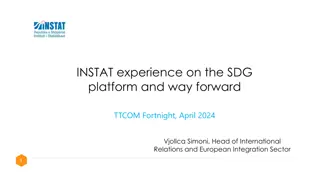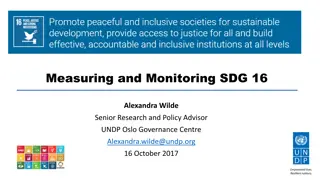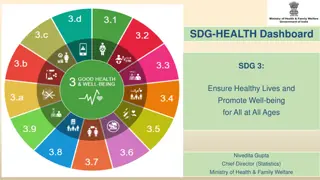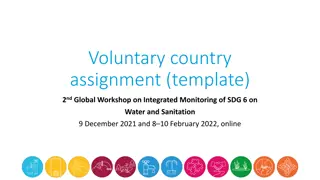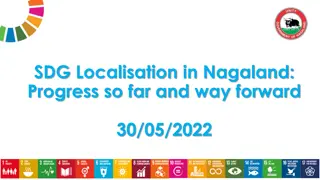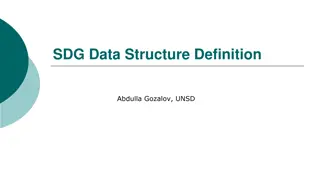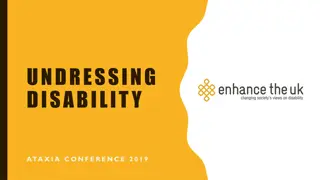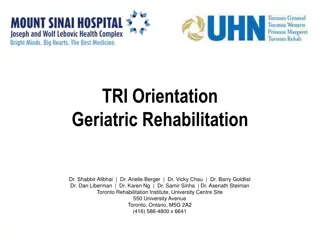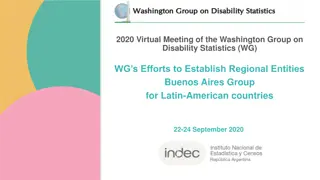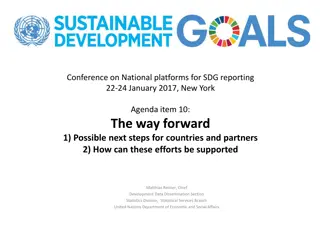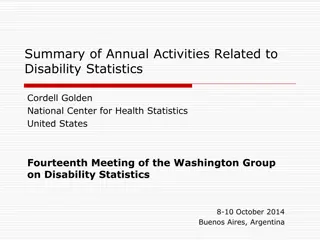Measuring Disability for SDG Follow-Up and Review
The article discusses the importance of measuring disability to support the follow-up and review of Sustainable Development Goals (SDGs) in the 2030 Agenda. It highlights the inclusion of disability considerations in the SDGs, challenges in implementing the agenda, and the global indicators framework for monitoring progress. The emphasis is on leaving no one behind, including persons with disabilities, to ensure the achievement of the SDGs for all.
Download Presentation

Please find below an Image/Link to download the presentation.
The content on the website is provided AS IS for your information and personal use only. It may not be sold, licensed, or shared on other websites without obtaining consent from the author. Download presentation by click this link. If you encounter any issues during the download, it is possible that the publisher has removed the file from their server.
E N D
Presentation Transcript
Measuring Disability to support the follow-up and review of SDGs Margaret Mbogoni Focal Person Disability Statistics Programme United Nations Statistics Division mbogoni@un.org
Outline Disability in the 2030 Agenda for Sustainable Development => SDGs indicators relevant for disability analysis Statistical challenges in the implementation of the 2030 Agenda and the way forward
The 2030 Agenda for Sustainable Development Adopted by all countries; Has at its core the integration of the economic, social and environmental dimensions of development and the principle of leaving no one behind => Inclusive development Reduction of inequality Economic Identifies a roadmap for SD with goals and targets that are ambitious, integrated, indivisible, global in nature and universally applicable: SDGs =17 Goals and 169 Targets Social Environmental
Disability in the 2030 Agenda Although the word disability is not cited directly in the goals, disability is referenced in many parts of the GA resolution 70/1: Transforming our world: the 2030 Agenda for Sustainable Development. The principle of leaving no one behind , pledged by all MSs, urges Governments to empower the most vulnerable (including persons with disabilities) to ensure that the Goals and targets are met for all peoples.
Global SDGs indicators framework Global Indicators for follow up and review of the 2030 Agenda for Sustainable Development Agreed by the Statistical Commission in March 2016 Report of Commission adopted by ECOSOC in July 2016 -> GA Global indicators identified by the Inter-agency and Expert Group on Sustainable Development Goals Indicators (IAEG- SDGs members=28 Member States) Worked since June 2015; 3 plenary meetings; online consultations with all stakeholders for their comments/contributions; SDGs framework: 17 Goals, 169 Targets, 230 indicators Around 1/3 of indicators are people based ; http://unstats.un.org/unsd/statcom/47th-session/documents/2016-2- IAEG-SDGs-E-Revised.pdf
SDG Indicators and Disability Goal Issues covered: 1.3.1 Population covered by social protection floors/systems 4.5.1 Parity indices (disability/no disability) for education indicators 4.a.1 Schools with access to: (d) adapted infrastructure and material for students with disabilities 8.5.1 Earnings of female and males employees 8.5.2 Unemployment rate 10.2.1 People living below 50 per cent of median income 11.2.1 Population with convenient access to public transport 11.7.1 Area of cities that is open space for public use 11.7.2 Victims of physical or sexual harassment 16.7.1 Positions in public institutions 16.7.2 Population believing decision-making is inclusive and responsive 17.18.1 SDG inds at national level with full relevant disaggregation
Challenges/Opportunities Huge agenda! 230 global indicators with many requiring data disaggregation by various population characteristics, including disability status => Better use of existing and additional data sources + Better linkages/integration among data sources (e.g. geospatial information; administrative records); Coordination among data producers Measurability of some targets Current indicators set selected to ensure political balance, integration and ambition of Agenda is preserved => Complexity of the agenda (multidimensional goals + targets) and indicators to monitor (technically sound) = refinement of some indicators
Challenges/Opportunities (cont.) Availability of data to establish baselines for SDG indicators => assessment of data gaps + strategy/work plan to strengthen statistical country capacity and data availability Lack of statistical definitions, concepts/standards for new areas of concern => Development of statistical methods Global monitoring vs. National monitoring Potential source of discrepancies between the two sets of statistics => improve reporting mechanisms within National Statistical Systems (NSS) and between NSSs and international level; use of country-level data for global estimates; clear metadata disseminated and explaining eventual discrepancies;
Conclusions Rights and empowerment of PwD included in the 2030 Agenda for Sustainable Development Agenda! Assessment of data requirements and data gaps to meet the 2030 Agenda from disability lens National, regional international statistical communities working together to ensure evidence is available to follow- up and review progress towards SDGs





